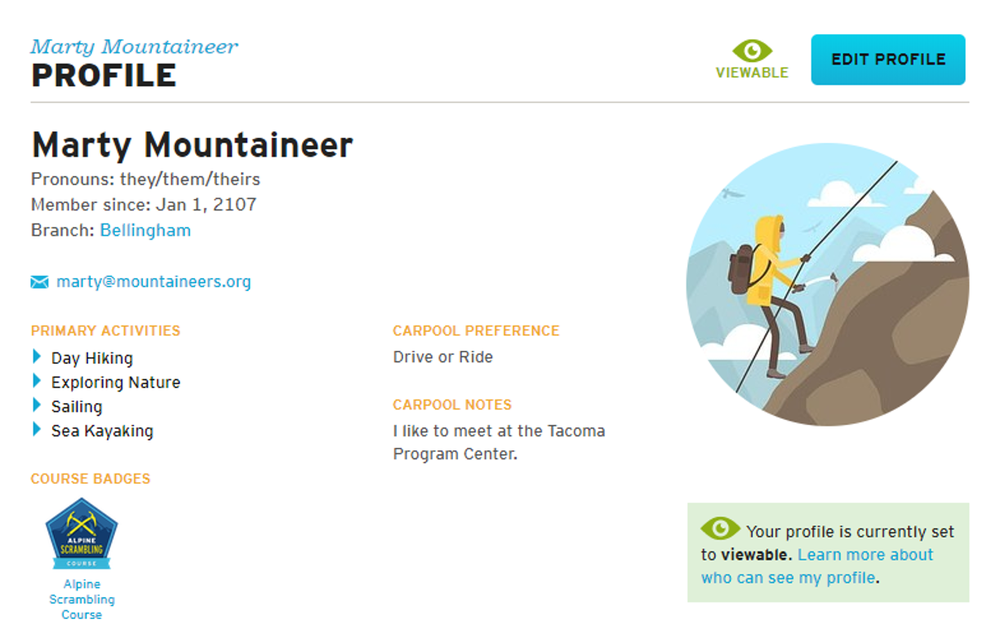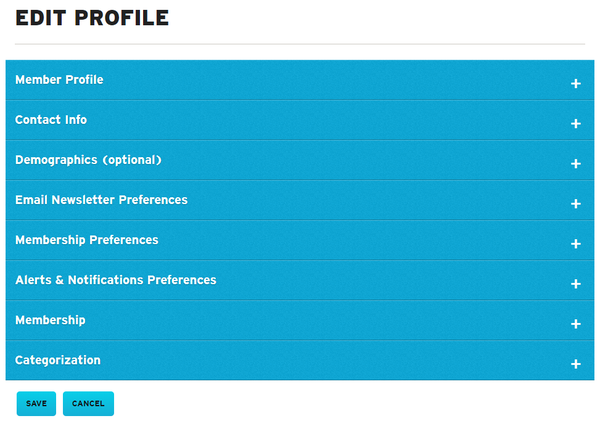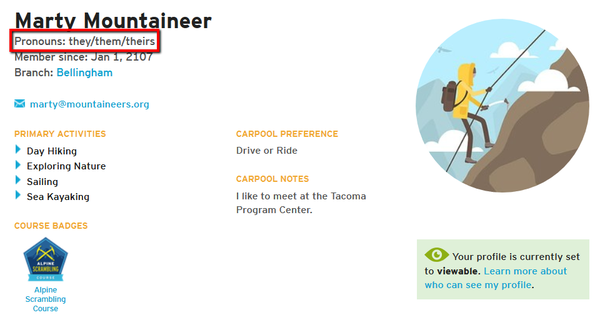
We believe a diverse and inclusive outdoors inspires unity, respect, and passion for the places we love, and that's why we seek to provide opportunities for all. As a reflection of our Core Values and the strategic priorities of Vision 2022, we’ve invested in internal equity to be sure everyone feels a place of belonging in The Mountaineers. Recently, we invested in improvements to the My Profile page for you to share your pronouns and demographic information.
It’s important to us that we provide a welcoming and inclusive community for our members, volunteers, and the public. In giving the option to share pronouns, we hope to create an inclusive space to support all identities, specifically for individuals within the LGBTQ community, in alignment with our mission and core values. Sharing pronouns helps create space for trans, non-binary, and genderqueer people to share how they would like to be addressed.
To measure our effectiveness in creating an environment where all people feel a sense of belonging, and make good on our commitment to increasing equity within The Mountaineers, we need a clear picture of who our volunteers, members, and guests are. By providing your demographic information, you help us track our progress and hold us accountable to delivering on our mission and core values. All the demographic questions are optional, and your information will be visible only to staff and will never be attributed to you as an individual. We will only use the data to provide overall snapshots of our organization for funding and tracking purposes. Your demographic information will also help us secure additional funding through grants.
Update Your Profile
To share your pronouns and demographic information, visit your My Profile page and click the "Edit Profile" button at the top right.

In the "Member Profile" section, you can add your pronouns. While you're there, be sure to make sure that your address, branch affiliation. and other information is correct.
Note: you can participate in courses and programs with any of our branches regardless of your branch affiliation; your affiliated branch just determines the branch you receive communications from. For example, if you live along the I-405/I-90 corridor you'll want to associate with our Foothills branch (named for its location in the foothills of the Cascades) so that we can send you emails about our Eastside-based events. (Within the "Alerts & Notifications Preferences" section you can update the email notifications you receive, including opting into or out of branch emails and our paper vs. paperless version of the magazine. In September, we also made improvements to allow you to sign up for notifications about recently-listed courses and trips.)
In the "Demographics (optional)" section, please enter any demographic information you are willing to share with The Mountaineers. As stated above and within this section of your profile, your information can only be viewed by staff and will never be attributed to you as an individual. The data will be used only for overall funding and tracking purposes. All questions are optional, and we appreciate your responses.

Once you've entered your information, you (and other signed-in members with access to your profile) will be able to see your pronouns under your name in your profile.

Next Steps - Adding Pronouns to Rosters
Looking ahead, we'd like to add pronouns to activity, course, event, and committee rosters too. Like every other technology improvement request, adding pronouns to rosters has been logged as an idea and will be traced in our Feedback system. It needs to be researched and resourced before it can be scheduled. Making technology improvements to rosters is a complicated process. Visit our feedback system to follow the progress of this project.
More resources
What are pronouns?
Pronouns are words used instead of a name. They reflect how we refer to ourselves and how we’d like others to refer to us. Common pronouns include they/them/theirs, she/her/hers, and he/him/his. A person’s pronouns may change over time, and some people are comfortable with more than one pronoun (she/they, for example).
There are many practical reasons to display pronouns. At the most basic level, many names are not gender-specific and sharing one’s pronouns is an effective way to provide pertinent information on how to refer to someone. Sharing pronouns is also a good way to help others avoid making assumptions about your gender
Note: An individual’s gender presentation (i.e. what gender you might initially perceive them to be) may not necessarily match their gender identity or their personal pronouns. If you're unsure of what pronouns someone uses, the most respectful thing to do is to ask – and then, of course, to use them!
Where can I learn more about pronouns and how to create a supportive environment for all?
A good starting point, including resources and examples, is the Washington State Employees’ LGBTQ+ Business Resource Group’s document on pronouns. And www.mypronouns.org lays out information on why pronouns matter and how to ask for and use them.
How can "They" be used for one person? It's not a singular word.
In September, "Merriam-Webster added gender-neutral pronouns “they” and “themself” to the dictionary. While “they” may be increasingly common in modern language as English speakers strive for more inclusive words, its use as a singular pronoun is not new," and this year, Merriam Webster named 'They' as its word of the year for 2019.
Where can I learn more about The Mountaineers efforts to increase equity and belonging?
To get involved with these efforts, visit our E&I Committee page to see the latest news or contact Kristina Ciari to sign up for the working group, and of course attend our leadership development series seminars devoted to making the outdoors a place where everyone feels belonging.
 The Mountaineers
The Mountaineers